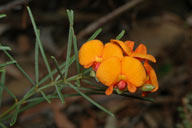In Flower This Week
A news sheet prepared by a Gardens' volunteer.
Numbers before each plant refer to temporary IFTW labels in the gardens.
Numbers in square brackets [ ] refer to garden bed Sections. Plants in flower are in bold type.
View past issues of 'In Flower This Week'.
17 September 2014
Gastrolobium involutum click for larger image |
The Gardens are full of spring flowers at this time. Feast your eyes in all directions.
- Rhodanthe chlorocephala [Section 221; also pictured above] is on your right in a pot as you leave the Visitor Information Centre. The bright pink flowers show up on fresh green foliage. Rhodanthe is a genus of native Australian daisies widely grown for their attractive flowers and foliage. The flowers are long-lived and dry well.
- Gastrolobium involutum [Section 221], also on the right in a pot, is an erect spreading shrub with linear leaves and orange pea flowers. It occurs naturally in a restricted area near Esperance, Western Australia.
- Philotheca myoporoides subsp. acuta [Section 174], on the right, is a neat bush with masses of pale pink flowers opening from darker pink buds. It grows naturally in western New South Wales around Lockhart.
- Acacia boormanii [Section 210], or Snowy River Wattle, on your left, has fine needle foliage and masses of golden balls of flowers. It is a medium-sized, suckering, multi-stemmed, copse-forming shrub, with a native range in the alpine country of south eastern Australia.
- Grevillea ‘Scarlet Sprite’ [Section 174], on the right, is a cultivar of G. rosmarinifolia and has bright pinkish-red spider flowers with green needle foliage.
- Chorizema cordatum [Section 174] or Heart-leaved Flame Pea, on the right in a pot, is a showy weeping shrub with vivid red/orange flowers and bright green prickly foliage. It grows naturally in the moist southwestern parts of Western Australia.
- Thelychiton speciosus [Section 125], on your left, is a popular and widely grown orchid previously known as Dendrobium speciosum. The Rock Lily or Rock Orchid has dark-green leaves and racemes of showy cream flowers. It grows on rocks or trees.
- Leionema elatius subsp. beckleri [Section 125], on your left, has shiny green leaves and clusters of scented white flowers. It is threatened in the wild and grows near rainforest on the escarpments of northern New South Wales and Queensland.
- On your right as you turn right along the bitumen road is Chamelaucium ‘Cascade Brook’ [Section 17], or Geraldton Wax. Endemic to Western Australia, this open airy bush has masses of purplish-pink 5-petalled flowers with darker centres.
- In the same bed, also on your right, is another Waxflower cultivar Chamelaucium uncinatum ‘Murfit Rose’ [Section 17], with paler pink flowers with yellow centres.
- Prostanthera rotundifolia [Section 78] or Round-leaved Mint Bush, on your right, has deliciously-scented foliage and many purple flowers. It occurs widely throughout eastern Australia.
- On your right is Acacia pravissima ‘Kuranga Cascade’ [Section 15j], a weeping or prostrate wattle with triangular grey-green phyllodes and masses of golden balls of flowers.
- Also on the right is Grevillea monticola [Section 14], which has stiff, prickly, holly-like leaves covered with many clusters of cream flowers. It occurs in the southwest of Western Australia.
- Grevillea vestita [Section 20], on the right, is a large open bush with many starbursts of white flowers. It is a shrub endemic to the southwest of Western Australia.
- Logania albiflora [Section 191h], on your left, has strongly-scented clusters of flowers and dark green needle-like foliage. It grows naturally in Victoria, New South Wales and Queensland. The Australasian genus Logania was named after James Logan (1674–1751), an Irish-born American politician and botanist.
Rosalind Walcott
![Director of National Parks [logo]](../../../../images/dnp_90px.gif)







